Woolly Aphids: How to Control and Treat Woolly Aphids (With Pictures)
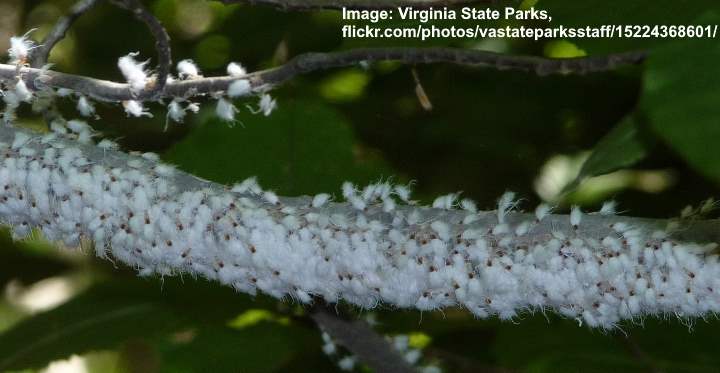
Woolly aphids are sap sucking insects that look like white fuzzy bugs as they have a white covering that looks like cotton or wool. It’s easy to mistake the white cotton wool-like appearance of woolly aphids for fungal plant growth. Woolly aphids tend to affect fruit trees and ornamental shrubs.
Controlling and getting rid of woolly aphids can be challenging. Woolly aphids have white fluffy waxy coating on their oval bodies that tend to make them immune to typical bug control methods such as horticultural soaps and neem oil.
The best way to control woolly aphids usually involves removing them with a strong jet of water or using a brush. Another way to get rid of woolly aphids is to use natural predators that feed on aphids, such as parasitic wasps, green lacewings, and ladybugs.
The good news is that a woolly aphid infestation rarely affects the health of mature trees and shrubs. However, the fluffy, cottony woolly aphids on branches, stems, and foliage can look unsightly. Additionally, affected trees can develop lumpy growths, resulting in cankers where fungus infections can start.
The best way to get rid of woolly aphids is to prevent them from damaging woody plants, trees, and shrubs.
This article is a guide to controlling and treating woolly aphids. You will find out about their lifecycle, how to identify the white fluffy insects, and the best natural control methods.
Woolly Aphid Facts
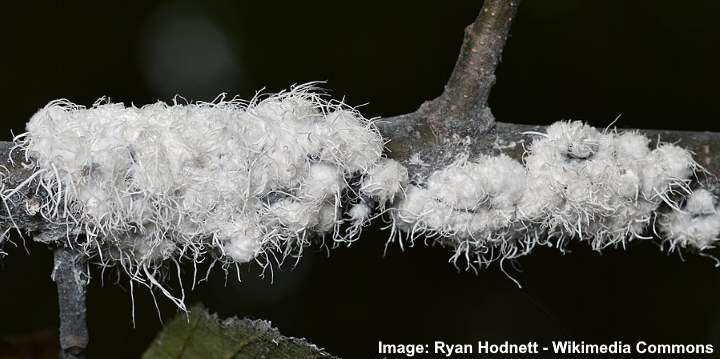
Woolly alder aphids (Prociphilus tessellatus)
Woolly aphids are black aphids that have a white waxy secretion covering their bodies. There are various species of woolly aphids, and all belong to the insect family Aphididae. Some—but not all—woolly aphids are in the subfamily Eriosomatinae. Adult woolly aphids are also winged insects that fly to new locations to lay eggs.
Woolly aphids feed on plants by biting into plant tissue and sucking the sap. The cotton wool-like insects feed on plant foliage, stems, buds, bark, and roots. Although plant damage is limited, an infestation of white fuzzy aphids can result in secondary plant fungal diseases.
In flight, woolly aphids look like tiny white fuzzy cottony flying bugs. Their unusual appearance in flight gives the woolly aphids names such as ‘flying mice,’ ‘cotton fairies,’ ‘fluff bugs,’ ‘poodle flies,’ and ‘fluffy gnats.’
Not all types of aphids have a cottony-wool appearance. Plant-destroying aphids can be green, white, brown, gray, or pink. Because these are flying insects, aphids are also called whitefly or greenfly.
What do Woolly Aphids Look Like?
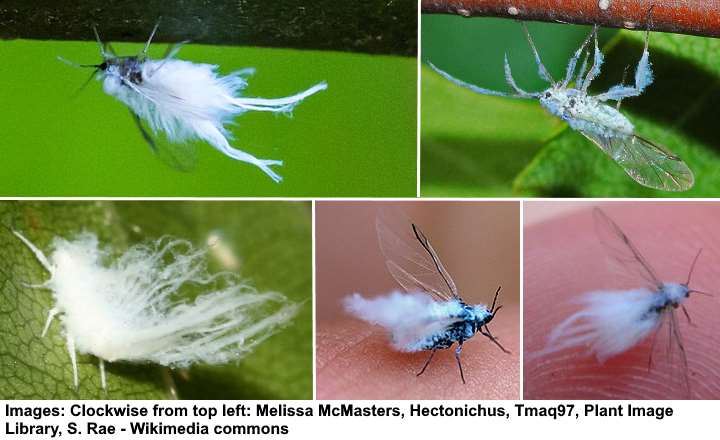
Various species of woolly aphids with white fuzzy coating
Woolly aphids look like tiny pear-shaped dark brown or black insects with a white furry coating. The waxy filaments make the aphids appear that they are covered with wool. Adult woolly aphids measure up to 2 mm long.
Close-up pictures of woolly aphids show that they have dark oval bodies. Their bodies grow waxy white strands that give the creeping insects a dotted appearance with a furry end. In some respects, woolly aphids look like mealybugs.
Although individual furry ‘bugs’ are difficult to spot, a group of woolly aphids looks like a ball of cotton wool. You can spot woolly aphids under leaves or covering branches, stems, or feeding on tree cankers.
Woolly aphid nymphs look like tiny versions of adult insects. Typically, you only notice immature woolly aphids as they form large white fluffy masses like sugar candy on twigs and branches.
Woolly aphids vs. mealybugs
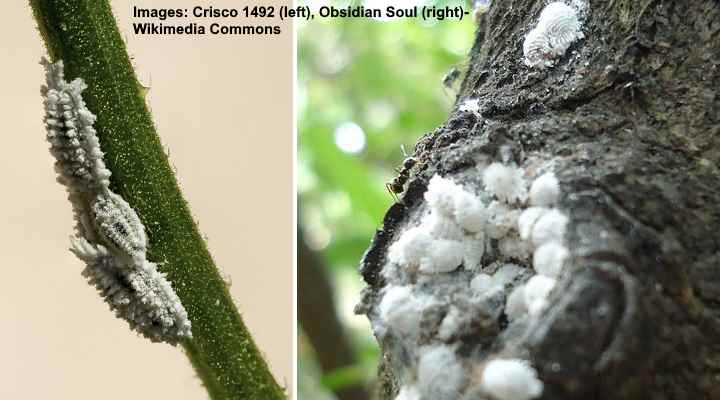
A close up picture of mealybugs
An attack of woolly aphids is often mistaken for a mealybug infestation. Both these sap-sucking creatures have soft bodies and a white cottony appearance. Woolly aphids tend to move around plant foliage faster than mealybugs. The aphid insects also prefer feeding on leaves and thin stems, whereas mealybugs tend to congregate in stem joints.
You’ll also notice that if you disturb woolly aphids, they tend to fly away or scurry away fast. Mealybugs, unlike aphids, move slowly and don’t fly.
Additionally, woolly aphids and mealybugs are from different families. Woolly aphids belong to the family Aphididae, and mealybugs are a member of the Pseudococcidae insect family.
Related reading: How to spot the signs of a mealybug infestation.
Woolly Aphid Life Cycle
The life cycle of woolly aphids consists of the egg, nymph, and adult stages. Females lay eggs in crevices on the bark of the host plant. The aphid eggs hatch in around one week, and the nymphs can live on the roots in fissures of the host. Woolly aphids reach maturity in four to ten days and can start producing offspring.
In spring, aphids become active and develop their characteristic woolly coating. The fuzzy insects start feeding on tree and plant sap and continue reproducing. Woolly aphids are most active in mid to late summer when they begin feeding on younger shoots.
Many generations of woolly aphids can occur during summer on a single tree or shrub. When this happens, new woolly aphids develop wings and travel to infest new plants.
Female woolly aphids are capable of laying hundreds of eggs, creating several generations.
In total, the lifespan of a woolly aphid is one month. Eggs that are laid in the fall overwinter on trees until spring.
Where do Woolly Aphids Live?
Woolly aphids tend to infest fruit trees and ornamental shrubs. Individual species of woolly aphids usually only affect one type of plant. You can generally find woolly aphids feeding on the underside of leaves, branches, buds, or new shoots on an infested tree or shrub. It is usually easy to spot white furry aphid activity due to the fuzzy white substance on plants.
Some woolly aphid species, such as the woolly apple aphid (Eriosoma lanigerum), only infest apple trees. The Eriosoma Americanum is the woolly elm aphid that feeds on elm trees. Various woolly aphid species live and feed on apple, pear, hawthorn, ash, and oak trees.
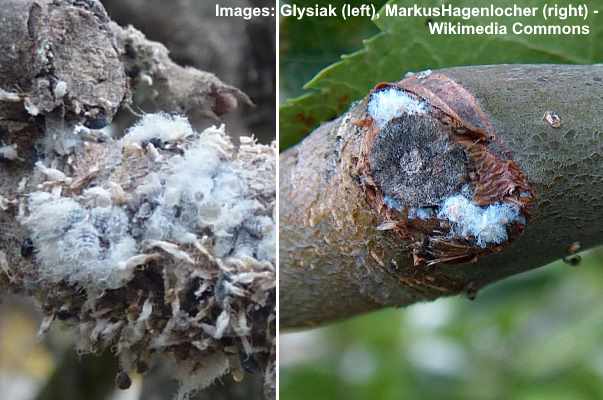
Woolly apple aphid (Eriosoma lanigerum)
You will also find some types of woolly aphids that infest ornamental shrubs. For example, the firethorn (Pyracantha) and rock cotoneaster (Cotoneaster horizontalis) are particular favorites of some woolly aphid pests.
How to Identify Woolly Aphids on Garden Plants
You can identify woolly aphids by looking for white fluffy ‘bugs’ on plants. The brownish-black aphids have a pear-shaped body with an identifiable fluffy white coating. Or you can identify woolly aphid activity by characteristic white cottony substances on twigs and branches. You may also notice bumps or galls on infected tree trunks.
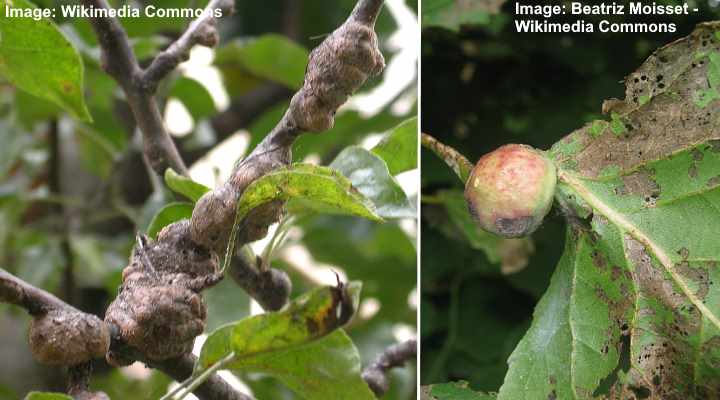
Woolly aphid gall damage on infected apple tree (left) and on the petiole of cottonwood leaf (right)
It’s not difficult to identify a sizeable woolly aphid infestation. Masses of sugar candy-like patches will be easily recognizable on branches, stems joints, and other parts of the tree or shrub. It’s also possible to see small groups of fuzzy white bugs in tree crevices.
Another way to identify woolly aphids is by the effect the furry bugs have on plants. In summer, woolly aphids tend to feed on younger shoots. Biting into the soft woody stems causes lumpy growths to appear. You will notice the evidence of woolly aphids when pruning during winter. The bumpy growths tend to split in the frost. This result of the aphids makes the plant susceptible to canker.
It’s also good to remember that the characteristics of woolly aphid activity can be like mealybug or scale insect plant damage.
What Does Plant Damage Caused by Woolly Aphids Look Like?
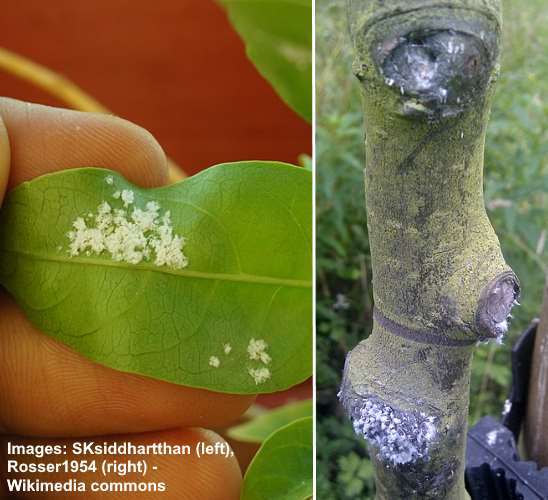
Woolly aphid on jasmine leaf (left) and on crab apple bark (right)
Woolly aphids damage plants by sucking juices from the foliage and stems. You can recognize signs of aphid damage by yellowed leaves, poor plant growth, twisted curled leaves, and branch dieback. Typical damage woolly aphids do is to the plant’s appearance—the cottony coating on ornamental trees and shrubs looks unsightly.
Another indication of woolly aphid damage is cankers or galls that develop on tree limbs and roots. This aphid damage happens when the critters pierce young shoots to feed on sap. This plant damage allows fungal diseases to affect plant growth.
Powdery mildew is also an identifiable sign of woolly aphid activity. However, it’s good to remember that this white powdery substance on leaves can result from too much humidity in cold weather or poor air circulation.
You can also recognize the damage caused by woolly aphid if there is a sticky honeydew on plants. This sweet sticky substance not only attracts ants to your garden but also causes issues with sooty mold—a type of black fungus that looks like soot.
Thankfully, the damage to ornamental trees and shrubs that woolly aphids cause is usually superficial. Getting rid of the woolly aphids usually improves the plant’s appearance and restores vigorous growth.
How to Control Woolly Aphids
Woolly aphids rarely cause lasting damage to trees and shrubs, so it’s unnecessary to use pesticides to get rid of them. Generally, pesticides are not effective for woolly aphid control due to the aphid’s waxy secretion that prevents the pesticide affecting their bodies.
You can control the sap-sucking woolly aphids by washing them off with water, brushing them using a stiff brush, or introducing beneficial insects.
It’s generally advisable to avoid using pesticides to control woolly aphids. Apart from having limited efficacy, pesticides can harm beneficial insects and kill pollinators. There is also the potential for harmful toxins getting into the food chain.
To use organic woolly aphid control methods, you should identify the aphids in spring. If you notice signs of tiny brownish-black flies or see white furry bugs, it’s an indication that you should take swift action.
Let’s look at some of the most effective methods of controlling the numbers of woolly aphids in your garden.
Wash Plants to Get Rid of Woolly Aphids
A strong jet of water is an effective non-pesticide control method for woolly aphids. If you have a pressure spray, wash down affected trees and shrubs to remove the cotton candy-like substance and dislodge woolly aphids. You should check shrubs and trees regularly and blast the aphids with water to prevent them from becoming a nuisance.
You can remove the remaining woolly aphids by using a stiff brush and a bucket of soapy water to scrub tree trunks and reachable branches.
In spring, try to identify trees or shrubs that could have woolly aphids and wash down the bark, stems, and branches.
Encourage Woolly Aphid Predators to Kill Woolly Aphids
Control woolly aphids naturally by introducing predators that feed on aphids, as well as their larvae and nymphs. Parasitic wasps such as Aphelinus mali, ladybugs, hoverflies, and lacewings can help keep woolly aphid numbers to a minimum.
Scientific research suggests that parasitic wasps are an effective biological control for woolly aphids. A 2006 study found that introducing Aphelinus mali helped to control certain species of woolly aphids. Also, the Washington State University recommends introducing a variety of aphid predators such as parasitic wasps, green lacewings, and ladybugs to “enhance the biological control of woolly apple aphid.”
Use Homemade Sprays to Treat Woolly Aphids
Some people suggest using a homemade soap spray or neem oil spray to get rid of woolly aphids. It’s said that the natural insecticide properties of neem oil kill woolly aphids and stop them from breeding. While it’s true that neem oil can be effective for typical—non-furry aphids—there is no evidence suggesting it’s useful for woolly aphid control.
If desired, you could try using neem oil on aphids. Fill a spray bottle with 1 quart (1 l) of warm water. Add 2 teaspoons of neem oil and 1 teaspoon of dish soap. Mix well to combine the ingredients. Then thoroughly cover the infected branches and leaves with the neem oil mixture.
The neem oil may not rid your ornamental trees and shrubs of woolly aphids. But the natural pesticide could help get rid of other pests such as mealybugs, whitefly, greenfly, and gnats.
How to Prevent Woolly Aphids
The best way to keep your beautiful decorative trees, shrubs, and plants healthy is to prevent woolly aphids in your garden. Thankfully, you rarely have to worry if you spot a few fuzzy white insects on your plants. But the quicker you get rid of the white fuzzy ‘bugs,’ the less chance you have of dealing with a pest infestation.
Here are a few ways to prevent woolly aphids on your garden trees, shrubs, and flowers:
Check for signs of woolly aphids in spring. It’s a good idea to check under leaves and in crevices of fruit trees, as well as elm, oak, ash, and hawthorn trees for white fluffy aphids or waxy-looking oval insects. You can use a brush and soapy water or a jet of water to dislodge the critters.
Encourage beneficial insects that are natural aphid predators to your garden. Planting daisies, asters, and yellow flowers help attract ladybugs, lacewings, and hoverflies. These insects will feed on aphid eggs and nymphs, keeping their numbers low.
Remember, while broad-spectrum insecticides may kill aphids, they will also eradicate beneficial insects. So, it’s a good idea to avoid spraying trees and shrubs with chemicals.
If you decide to plant new apple trees, choose cultivars resistant to apple woolly aphids (Eriosoma lanigerum).
After winter pruning, paint the ends of cut branches with organic tree paint to help prevent insect infestations in the following spring.
Related articles:
